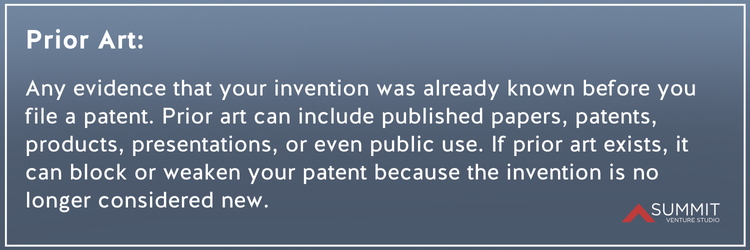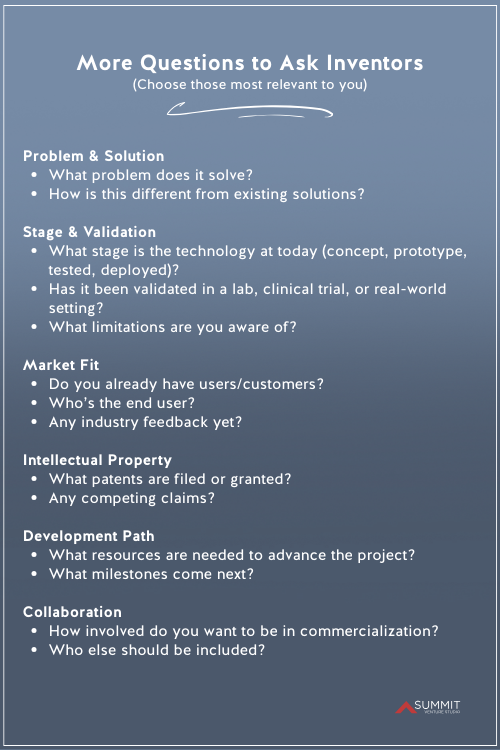Part 5 of 6 · The Entrepreneur’s Guide to University Tech Transfer
Licensing university technology can be the turning point where your startup goes from concept to reality. Founders face two important moments in this process: giving professional feedback when a disclosure isn’t the right fit, and knowing the steps to take when they find an opportunity worth pursuing.
At SVS, we’ve licensed technologies from multiple universities and built startups around them. Along the way, we’ve learned that how you handle feedback and licensing determines whether you’re seen as a serious partner or just another name in the inbox.
Act 1: Why Feedback Still Matters
When a university tech transfer office (TTO) shares opportunities, they’re investing time. Even if a disclosure isn’t the right fit for you, your response matters.
- Be Specific. Instead of “not interested” or “not a fit,” explain if it’s too early stage, outside your market, commercially limited…
- Be Constructive. Point out what might make it more viable (e.g., proof of clinical validation, bigger market need, etc.)
- Be Consistent. Keep responding so the TTO knows you’re engaged.
Your feedback builds trust. It shows you appreciate and understand the process and encourages TTOs to keep sending you opportunities.
Act 2: When the Answer Is Yes – First Steps to License University Technology
When a disclosure sparks your interest, speed and clarity are critical. Here’s a playbook for moving forward:
1. Signal Your Interest Clearly
Reply promptly, identify the exact disclosure, and state your intent: “I’d like to explore the opportunity to help commercialize this technology.”
2. Request the Right Documents
- Confidential summary (beyond the public abstract)
- Patent filings or prior art search
- Inventor bios and background
Almost always, this requires signing an NDA. [See post #3 on the tech transfer process.]

3. Meet the Inventors
When you’re ready to learn more, request a meeting with the inventors. Make this request through the tech transfer office, not directly to the researcher. This keeps the process professional and ensures the TTO is aligned and supportive.
On the call, focus on uncovering context:
- What problem does this solve?
- What’s been validated so far?
- What resources are available?

4. Conduct Initial Validation
Start mapping a business model canvas, test assumptions with customer discovery interviews, and size the market. For practical tools, see our checklist for evaluating university IP.
5. Negotiate Access
To move forward with a university technology, you’ll need to negotiate a formal agreement with the tech transfer office. These agreements outline your rights and responsibilities, and they typically come with costs, whether option fees, license fees, or even milestone-based royalties.
If you’re not familiar with option or license agreements, you’ll be well-advised to have them reviewed by a legal professional. These contracts define obligations, costs, and rights that can shape your startup’s future.
The most common pathways include:
- Option agreement: A time-limited “first right” to evaluate the technology.
- Exclusive license: Rights to commercialize with agreed royalties, fees, and milestones.
- Evaluation agreement: Access to use the technology for deeper diligence before licensing.
Some universities also negotiate for equity in the startup. In that case, the license agreement will specify the university’s ownership percentage, which will then appear on your cap table. Early clarity here avoids wasted effort later. For reference, see AUTM’s detailed Anatomy of a License Agreement for a breakdown of what terms and clauses you should expect, or Stanford OTL’s Licensing Process as an example of how a university might structure an agreement in the real world.
What’s in a University License Agreement?
(Topics you’ll likely negotiate with a tech transfer office)
Most university license agreements include a common set of topics. Here are some areas you should expect to negotiate:
- Scope of IP – patents, copyrights, or software included in the license
- Field of Use – where and how you can apply the technology
- Exclusivity – whether the license is exclusive or non-exclusive
- Financial Terms – upfront fees, royalties, milestone payments, sublicensing revenue
- Equity Stake – the university’s % ownership, if applicable
- Performance Milestones – timelines and goals you must meet (prototype, funding, launch)
- Reporting Requirements – periodic updates to the university on progress or sales
- Patent Costs – responsibility for filing, prosecution, maintenance fees
- Sublicensing Rights – ability to sublicense the IP to others
- Termination Conditions – when the agreement can end, and what happens to rights afterward
Recap
When you decline a deal, thoughtful feedback earns you respect. When you pursue one, professionalism earns you speed.
Do both consistently, and you’ll transform from “unknown founder” to a valued partner in the eyes of university tech transfer offices.
Remember:
- Feedback earns trust and keeps deal flow strong.
- Saying “yes” means acting quickly, requesting the right documents, meeting inventors, validating market fit, and negotiating licensing terms.
Together, these habits set you apart as a founder who knows how to license university technology effectively.
FAQ
Signal your interest clearly and request the confidential summary of the disclosure.
Yes. Most TTOs require at least a project-specific NDA before sharing details beyond the abstract.
Typically, options agreements, exclusive licenses, or evaluation agreements, depending on your needs and stage.
Feedback helps TTOs and inventors refine projects. It also builds trust so you continue to receive relevant opportunities.
It varies. With clear communication and preparation, initial agreements can be reached in weeks. But full licensing may take months.
Interested in exploring technologies worth commercializing?
We regularly evaluate technologies from our university partners. If you’re curious about reviewing opportunities and possibly stepping in as a co-founder, we’d like to hear from you.

